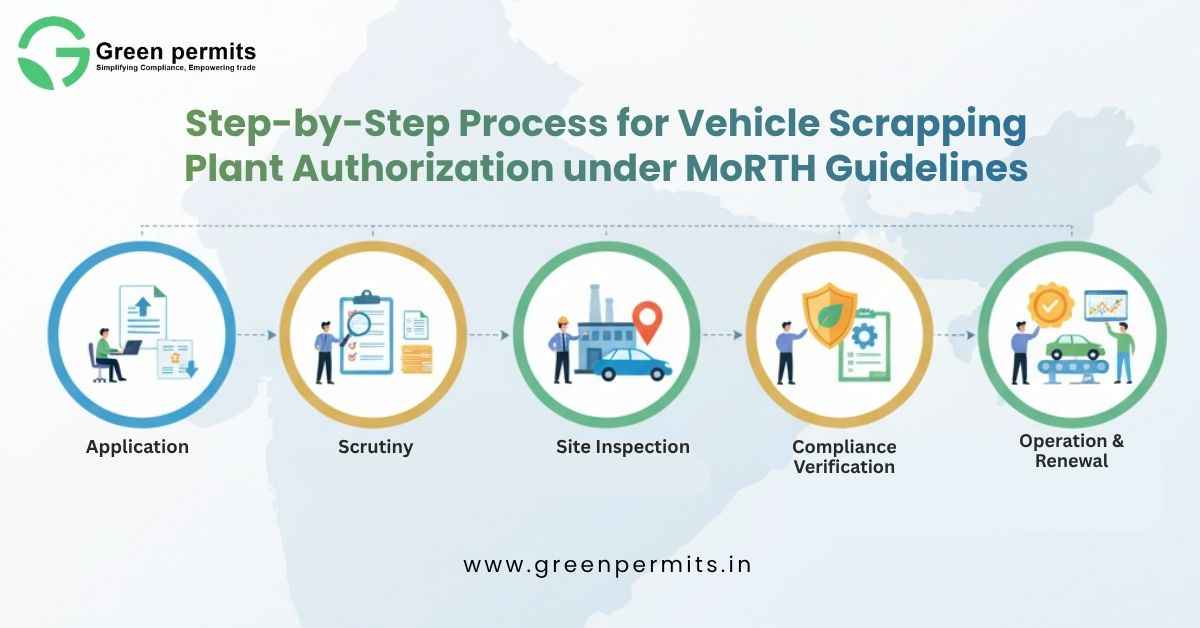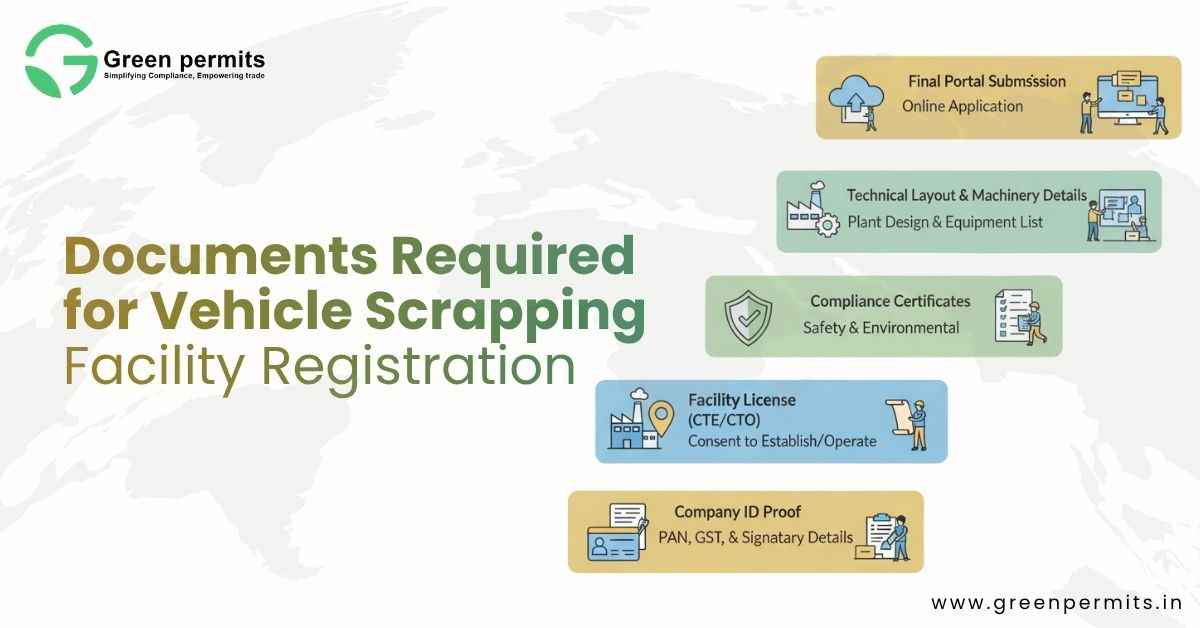When Pune-based entrepreneur Ravi Mehta from EcoDrive Recyclers Pvt. Ltd. saw his old fleet of delivery vans sitting idle, he realized he was sitting on more than scrap — he was sitting on an opportunity. Instead of selling metal waste at a throwaway price, he studied how countries like Japan and Germany built profitable recycling ecosystems. His research led him to the emerging business of vehicle recycling under India’s Vehicle Scrappage Policy, where registered recyclers earn from both sustainability and smart recovery.
Across India, business owners like Ravi are exploring this model to replace old vehicles and reduce pollution, while creating profitable recycling ventures. The Ministry of Road Transport and Highways (MoRTH) has made this possible through clear authorization rules for Registered Vehicle Scrapping Facilities (RVSFs).
Understanding the Vehicle Recycling Business Model
A vehicle recycling plant, also known as an Authorized Vehicle Scrapping Facility (AVSF), is a fully compliant industrial setup that dismantles and recycles End-of-Life Vehicles (ELVs). Once a vehicle’s fitness certificate expires, it can be scrapped, dismantled, and its usable materials recovered for resale or recycling.
Why the Model Is Gaining Attention
- India has an estimated two crore ELVs that will require processing by 2030.
- Scrappage incentives and GST benefits are attracting investors.
- OEMs (like Tata Motors and Maruti Suzuki) are partnering with recyclers for green procurement.
- The circular economy model ensures long-term profitability — materials recovered from one vehicle become inputs for another.
For entrepreneurs, this means tapping into a future-proof industry backed by both regulation and demand.
Capital Investment and Cost Structure
Setting up a vehicle recycling facility involves multiple layers of investment — from land and civil construction to depollution machinery and environmental compliance. Below is a realistic cost breakdown for a medium-sized RVSF capable of handling around 10,000 vehicles annually.
| Cost Head | Description | Approx. Cost (₹ Lakhs) |
|---|---|---|
| Land & Infrastructure | 1–2 acres for dismantling yard, stormwater drains, material sheds, boundary wall, weighbridge foundation | 120–150 |
| Machinery & Equipment | Depollution rig, vehicle lift, dismantling line, forklift, hydraulic press, shredders, cranes | 250–300 |
| Pollution Control Systems | Oil-water separator, fire suppression, air filtration, effluent collection, spill kits | 40–60 |
| IT & Security Setup | CCTV coverage, vehicle tracking system, ERP, CPCB portal integration | 25–40 |
| Licensing & Authorizations | CTE/CTO from SPCB, RVSF registration from MoRTH, Fire NOC, Factory license | 10–15 |
| Working Capital | Staff, utilities, transport, insurance, initial procurement of ELVs | 100–150 |
| Total Estimated Investment | For a plant processing 10,000 vehicles per year | ₹550 – 700 Lakhs |
Interpretation:
- A small dismantling facility (2,000–3,000 vehicles/year) may start at ₹2–3 crore.
- Large shredding plants with automation can exceed ₹12–15 crore depending on land value and machinery.
This capital can be financed through equity, MSME loans, or green credit programs supported by SIDBI and NABARD.
Regulatory and Licensing Roadmap
Unlike informal scrap dealers, authorized recyclers must secure a series of environmental and operational approvals before starting.
| Stage | Authority | What It Covers |
|---|---|---|
| Consent to Establish (CTE) & Consent to Operate (CTO) | State Pollution Control Board (SPCB) | Approval under the Air & Water Acts; validates the site and pollution controls |
| Hazardous Waste Authorization | SPCB/CPCB | Allows safe disposal of oils, batteries, and coolants |
| Vehicle Scrapping Authorization | MoRTH / State Transport Department | Confirms RVSF compliance with infrastructure & safety standards |
| Factory License & Fire NOC | Local Municipal / DIC Authorities | Ensures safe operation and worker protection |
| EPR Portal Registration | Central Pollution Control Board | Enables certificate trading and compliance reporting |
Failure to obtain any of these can delay commissioning or result in legal action. Many recyclers partner with consulting firms to streamline documentation and inspections.
Revenue Model and Profitability
The viability of a vehicle recycling unit depends on material recovery and operational efficiency.
| Parameter | Indicative Value |
|---|---|
| Annual Throughput | 10,000 vehicles (~15,000 MT of metal) |
| Average Material Recovery | 75 – 80 % (steel, aluminum, copper, plastic) |
| Monthly Turnover | ₹1.8 – 2.4 crore |
| EBITDA Margin | 18 – 25 % |
| Payback Period | 3 – 4 years |
Recyclers earn from:
- Sale of processed metal scrap to steel and foundry units
- Sale of usable parts and plastics
- OEM buyback or incentive partnerships
- EPR credit trading through CPCB’s digital marketplace
Compliance Risks and Penalties
While the policy supports legitimate recyclers, non-compliance can lead to serious penalties.
- SPCBs can impose environmental compensation under the Environment (Protection) Act.
- Operations without valid CTE/CTO risk immediate suspension.
- Fire safety or hazardous waste violations can invite plant closure and blacklisting.
A Delhi-based dismantler was fined over ₹20 lakh in 2023 for operating without an oil-water separator — a small oversight that halted their plant for three months.
Compliance, therefore, is not just a formality; it’s a business safeguard.
Case Example: Turning Scrap into Success
In Gujarat, EcoNova Recycle Industries began operations with just 2,500 sq m of land and a loan of ₹3.5 crore. By focusing on automation, waste segregation, and consistent SPCB reporting, the company achieved break-even in its third year. Today, it supplies processed scrap to two major automobile OEMs and has expanded capacity to 12,000 vehicles annually.
This story mirrors what’s possible when a recycling business is structured professionally — combining technology with compliance discipline.
Market Outlook and Future Opportunities
The Indian vehicle recycling industry is projected to grow from USD 11 billion in 2025 to USD 27 billion by 2032. Demand will be driven by:
- Mandatory vehicle fitness tests after 15 years
- Urban policies phasing out older vehicles
- Growing awareness of circular economy and ESG reporting
As more automakers pledge carbon neutrality, collaboration with certified recyclers will become part of supply chain compliance. Investors entering now can secure long-term partnerships and brand credibility.
Key Takeaways
- Minimum investment: ₹2 – 3 crore for small facilities
- Medium scale setup: ₹6 – 7 crore with 10,000 vehicle capacity
- Large automated plant: ₹12 – 15 crore
- ROI: 3 – 4 years
- Compliance: RVSF authorization, CTE/CTO, and EPR registration are mandatory
- Growth driver: Over 20 million ELVs expected by 2030
Conclusion
Vehicle recycling in India has evolved from an informal scrap trade into a regulated, investment-ready industry. With well-defined MoRTH guidelines and CPCB-backed EPR systems, the business offers both environmental impact and stable financial returns.
Entrepreneurs who adopt transparent processes, safety systems, and circular supply chains will find themselves at the forefront of India’s green industrial revolution.
📞 Book a Consultation
Talk to Green Permits Consulting LLC
📞 +91 78350 06182 | 📧 wecare@greenpermits.in
Book a Consultation to plan your RVSF setup, cost modeling, and compliance roadmap with expert guidance.
Book a Technical Call with Expert
FAQs
Around one to two acres, depending on storage and dismantling layout.
Typically 4–6 months from CTE application to RVSF license, if documentation is complete.
Yes. MSME-scale recyclers are encouraged under India’s Vehicle Scrappage Policy with financing support.
It’s considered a violation under the Environment (Protection) Act, leading to fines or suspension.
Yes. The waste management and recycling sector allows 100 % FDI under automatic route.



